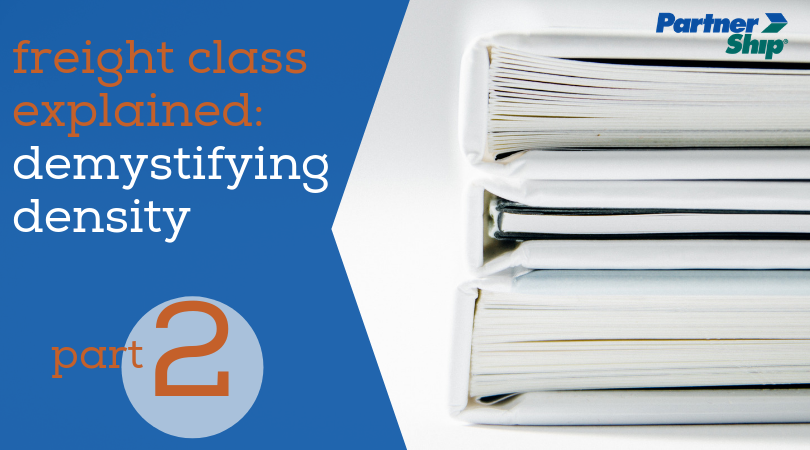
So, you've been brushing up on freight class and you're starting to get a hang of how it's determined. In the
first part of our freight class series, we learned that packaging, commodity type, and dimensional features all influence the final code that ultimately affects
your shipping price. Just when you thought you had a handle on the basics, we're going to throw you a little curveball. Some commodities have an added layer of mystery (and math) when it comes to their class: the density of the overall shipment. Let's sharpen some pencils and get down with density-based freight classifications.
What is density?
First thing's first, density is a method of measurement that relates the weight of your shipment to its dimensions, or pound per cubic foot. Typically, the higher the density, the lower the classification and vice versa. A good example of a high density shipment would be a pallet of bricks. Lower density shipments, or those that take up lots of space but are lightweight, are items such as ping-pong balls.
Why are some shipments density-based and what are they?
Commodities that are solid, heavy, and take up minimal space are very desirable to pretty much any freight carrier. Using density as a factor in determining freight class and pricing is
becoming the new standard, especially as freight demand increases and capacity decreases. Thanks to variables such as a shortage of drivers and strict trucking legislation, carriers are trying to weed out difficult or unprofitable shipments in order to make space for more standardized loads. Time and effort are money in this industry, and carriers are taking control of
who they want to ship for.
How do you calculate the density of a shipment?
Density is calculated by measuring the height, width, and the depth of the shipment, including skids and packaging. This is multiplied to determine cubic inches. If you have multiple pieces, multiply for each piece and add them together. Then, divide the total cubic inches by 1,728, or the total cubic inches in a foot. The result is the total cubic feet of the shipment's pieces. Divide the weight (in lbs.) of the shipment by the total cubic feet. The result is pounds per cubic foot, or density.
What is my freight class?
To help you better understand density-based shipments, we will look at a shipment of steel machinery parts, in a crate measuring 42 x 46 x 42 inches and weighing 500 lbs. By using the search function in
ClassIT for "machinery parts", we can see a broad grouping for 114000, or the Machinery Group:
Through this group, we are directed through sub-articles, where we can find the 133300 group "Machinery or Machines, NOI, or Machinery or Machine Parts, NOI". From there, we can view associated subgroups that refer to density and packaging:
You may also notice the "NOI" designation for this particular breakdown. "NOI" refers to "not otherwise indicated" and was implemented by the NMFTA for commodities that do not easily fit into existing classifications. Using NOI can be risky, since most products do have a specific freight class. Since "NOI" designations tend to draw attention from carrier inspection teams, it's critical that they are used properly, and that means density must be calculated to determine the subgroup.
In this example, and using the formula listed above, we can determine density using its dimensions and weight.
- Multiply the length, width, and height (42 x 46 x42) to get the total cubic inches (81,444).
- Divide the total cubic inches by 1,728 to get the total cubic feet (47).
- Divide the weight of the shipment (500 lbs.) by the total cubic feet (47). This will give you a density of 10.65.
Looking at the chart, we see that because of our crated packaging type, the top 4 subgroups are applicable. 10.65 falls under the subgroup 3, or class 92.5. In this class example, it is important that dimensions and weight are accurately measured in order to calculate the true density (and appropriate class) for the shipment. It's also crucial to note once more that packaging makes a huge impact. See how high the classes jump if the product is palletized or in packages other than secure crates or boxes.
LTL services are in higher demand than ever before. National freight carriers are in the driver's seat, and doing what they can to limit troublesome shipments - including those with a low density and high freight class. Once you've optimized your shipments for carriers, many shippers wonder about whether a Freight All Kinds (FAK) agreement may be a worthwhile perk. Next, we'll take a look at what goes into that FAK and if it's right for your business. The freight specialists at PartnerShip can guide the way so you aren't stuck staring at your calculator, and a high freight bill. Call 800-599-2902 to speak with a representative, or get a quote today.
